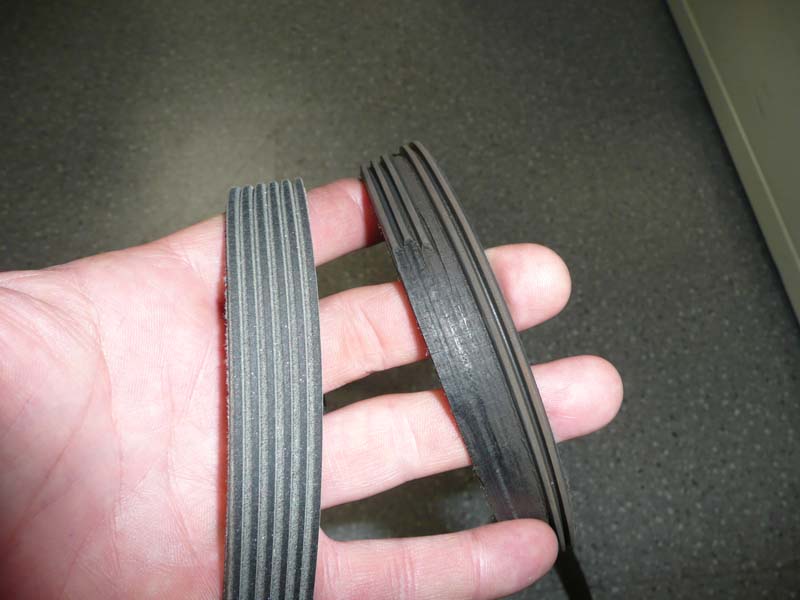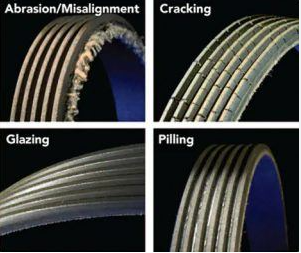
Your serpentine belt is a vital component of your vehicle. And if it breaks, you might end up stuck on the side of the road waiting for a tow truck. That’s why we recommend replacing the serpentine belt before it breaks to prevent further repairs and save you money down the road.
Not So Fun fact: If your serpentine belt is loose, you may have other mechanical problems like under-performing water pump, which can cause the engine to overheat.
What is a serpentine belt?
The serpentine belt is a long rubber belt that transports power to the engine accessories—the alternator, power steering pump, air conditioning compressor and (sometimes) the water pump.
You may have heard a serpentine belt referred to as a fan belt or accessory belt. This is because vehicles used to have multiple drive belts that connected the engine to the accessories (such as the radiator fan).
But modern vehicles (usually) just have one belt that winds through multiple pulleys to power all the accessories.
While using just one belt is the most efficient and reliable option, it also means that when your car’s serpentine belt breaks, everything stops working! You’ll lose power steering, the A/C will quit, your battery will eventually die, and the engine might overheat. Plus, it could also damage the engine accessories it controls.
How Long Does a Serpentine Belt Last?
Thanks to improvements in rubber technology, serpentine belts last much longer than they did back in the day. Most serpentine belts generally last between 50,000 and 100,000 miles. Eventually, your car’s serpentine belt will wear down from continuous exposure to heat and friction and will need to be replaced. What Is the Advantage of Having the Belt Replaced?
If you drive with a worn-out belt, you’re risking the failure of your engine’s accessories. When the belt slips or breaks, your car’s functions, such as the alternator and power steering pump, will likely stop working. A failing belt may also damage the parts it powers. Dealing with a broken belt or hose is bad enough, but if your engine becomes damaged, it’s even worse. By getting your belt regularly replaced, you can reduce the risk of your car breaking down. This allows you to enjoy your car and drive worry-free. This is why it is so important to get your serpentine belt replaced on a regular schedule.
What happens as a belt gets older?
They can wear, fray, crack or become shiny or “glazed,” and rubber parts can peel off the belt. An aging belt can also begin slipping or squealing, become contaminated with fluid or become misaligned, in which case it will need to be replaced. An old belt can even snap, leaving you up the creek; without one, drive torque to all of the engine’s accessories is lost.

Symptoms of a Bad Serpentine Belt
A serpentine belt is designed to last a long time. But eventually, the heat and friction will wear it down and it will need to be replaced. Here are some signs of a failing serpentine belt:
- Signs of wear (cracking, glazing, fraying, etc.)
- Squealing or chirping sound (indicates a slipping belt)
- Performance loss (power steering failure, sudden car battery drain or stalled engine)
- Check Engine Light
- Unusual noises

Do Cars Have Any Other Belts?
While most cars today only have a serpentine belt to control various systems, some vehicles have other belts. For example, select older rides may have a series of V belts in place of the serpentine belt. Some cars also have a timing belt to drive water pumps and oil pumps to the engine and other important parts.
What Else Should Be Maintained and Replaced?
Most serpentine belts in modern vehicles have tensioning devices. Serpentine belts can only perform optimally with the correct tension. Belt tensioners apply the perfect amount of tension to keep the serpentine belt running with the proper resistance and speed for optimum functionality. Other issues with your drivetrain may require replacing or interfere with your belt’s performance. When you get your serpentine belt replaced, you should also have your belt tensioner and pulleys looked at.
What can happen if a serpentine belt is not replaced when needed?
Failure to replace a worn serpentine belts will result in poor engine performance and, eventually, non-performance. A glazed or stretched belt does not travel across the pulleys; instead it slips across, leading to fewer turns of the pulley. Water pumps will not circulate coolant as well, leading to a higher running temperature and inefficient engine performance. Alternators will not supply as much electricity, which will shorten battery life. Air conditioner compressors will not turn as fast and the interior of the car will not be as cool as expected. A frayed or cracked timing belt will eventually break, and none of the accessories will function: steering will become very difficult, the air conditioner will blow warm air, and the car will run until the stored power of the battery is depleted.
Bring your vehicle to Hillside Auto Repair. We will thoroughly examine your vehicle, identify any damage to your belt, and replace it at an affordable price. Plus, our serpentine belt replacement service comes backed by our 3-year/36,000-mile service warranty. It’s what you should expect from The Professionals You Can Trust!